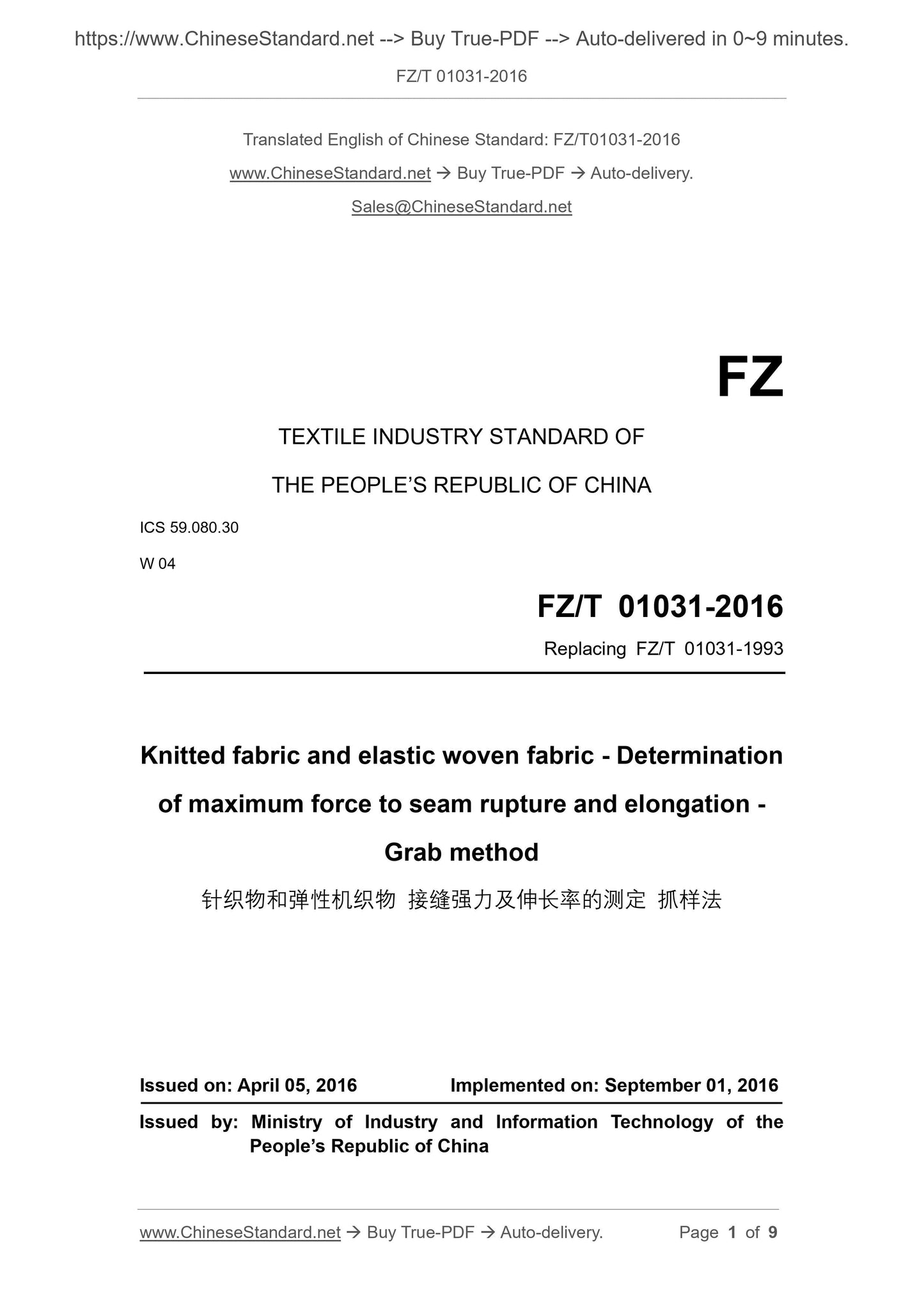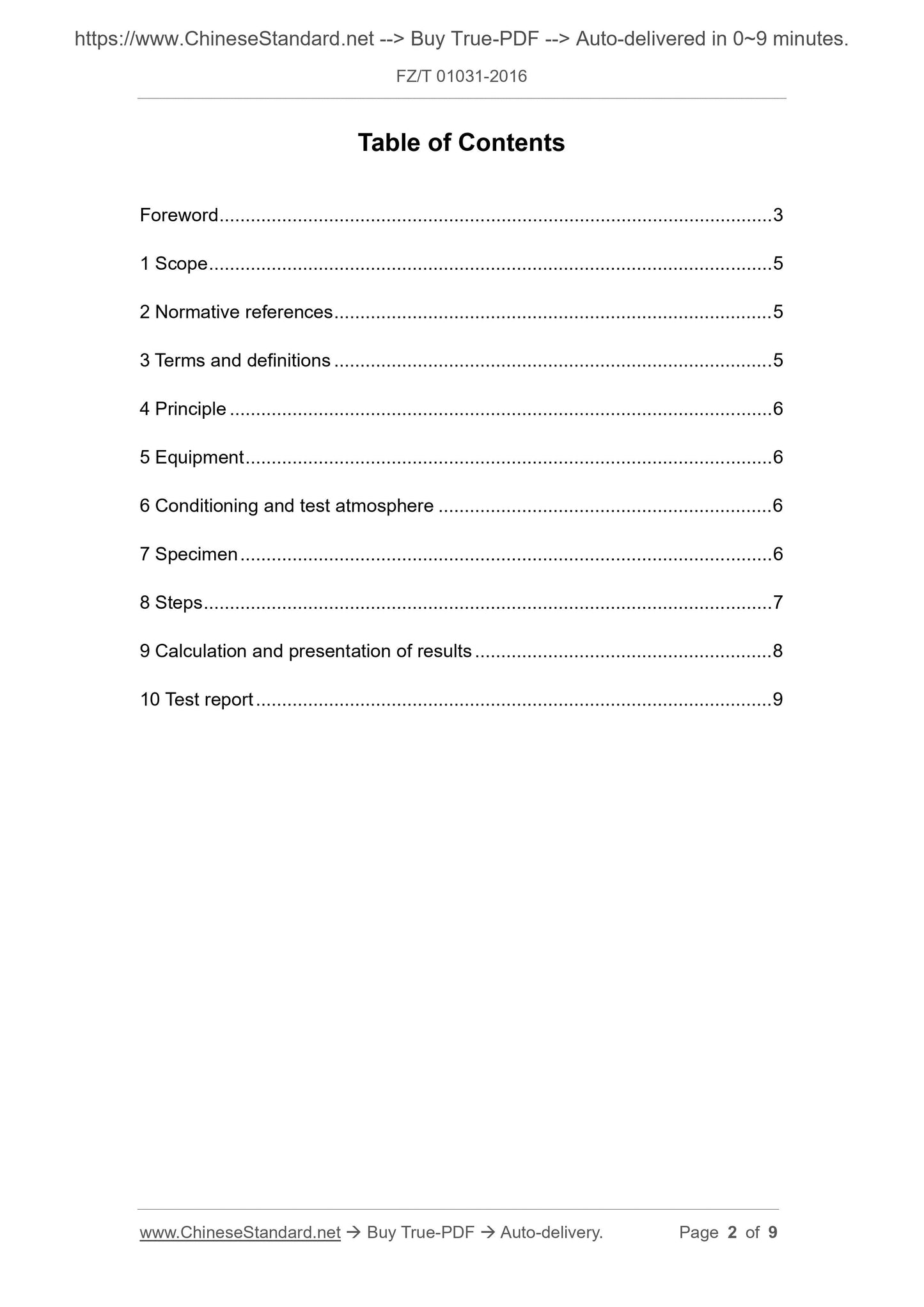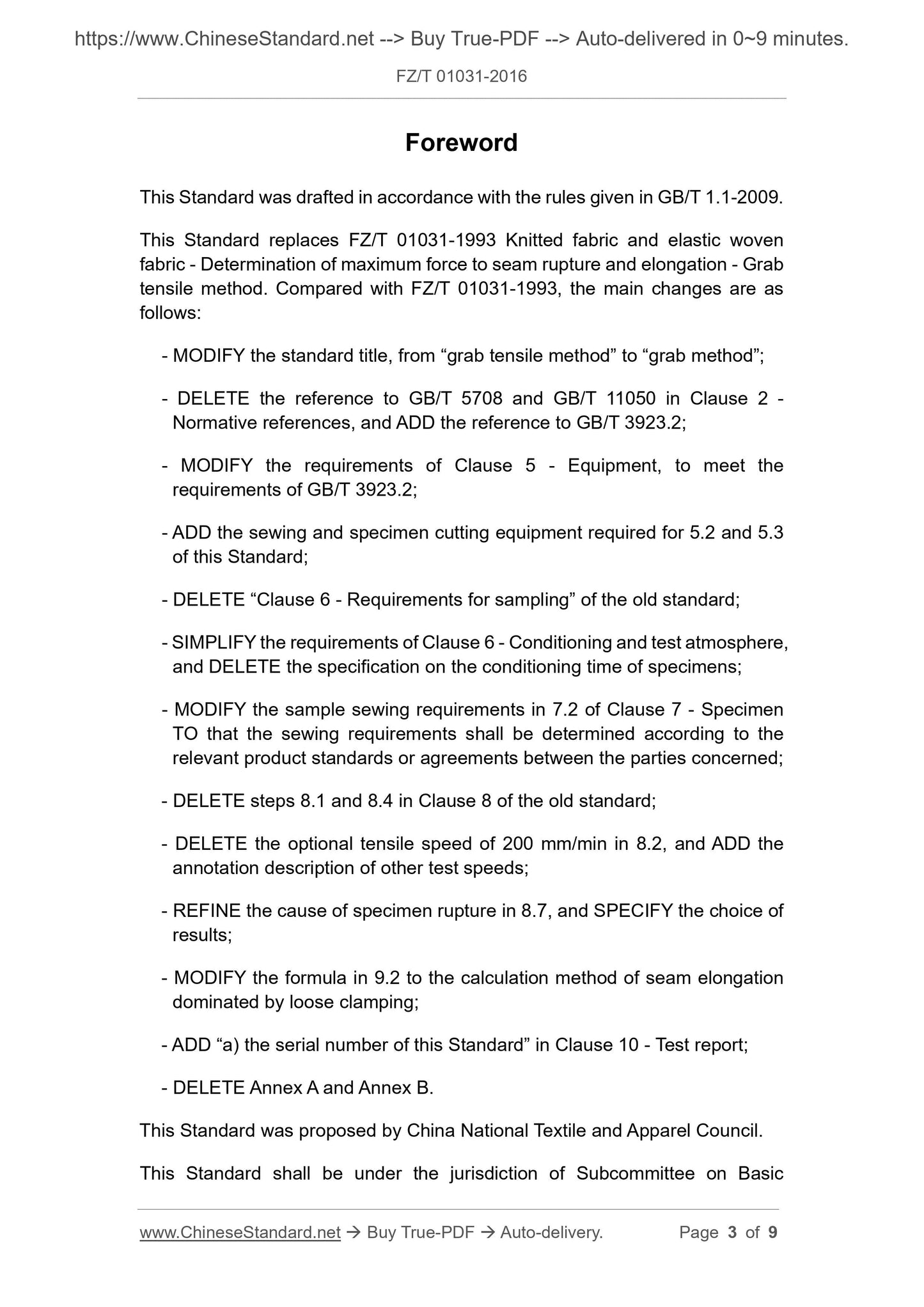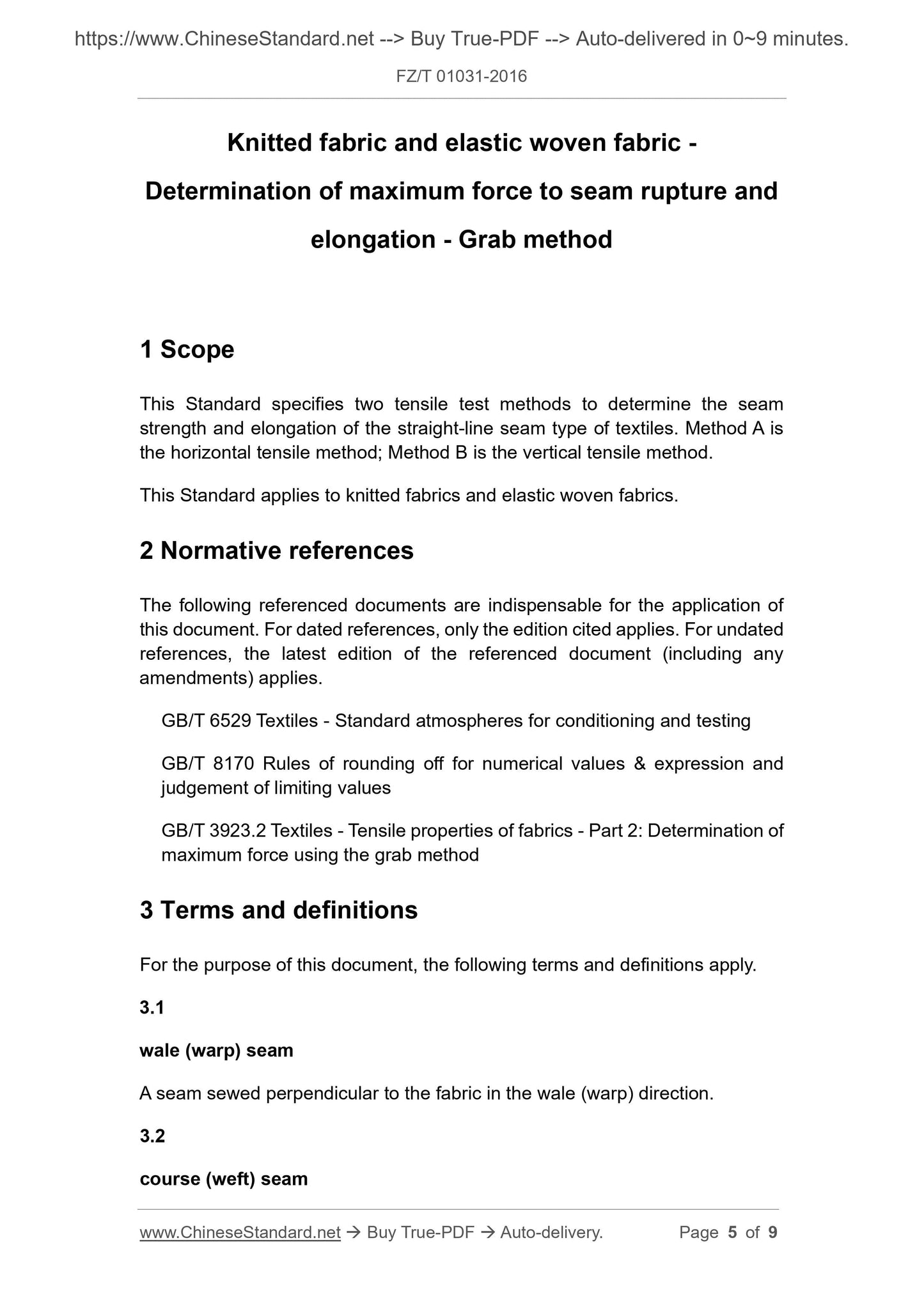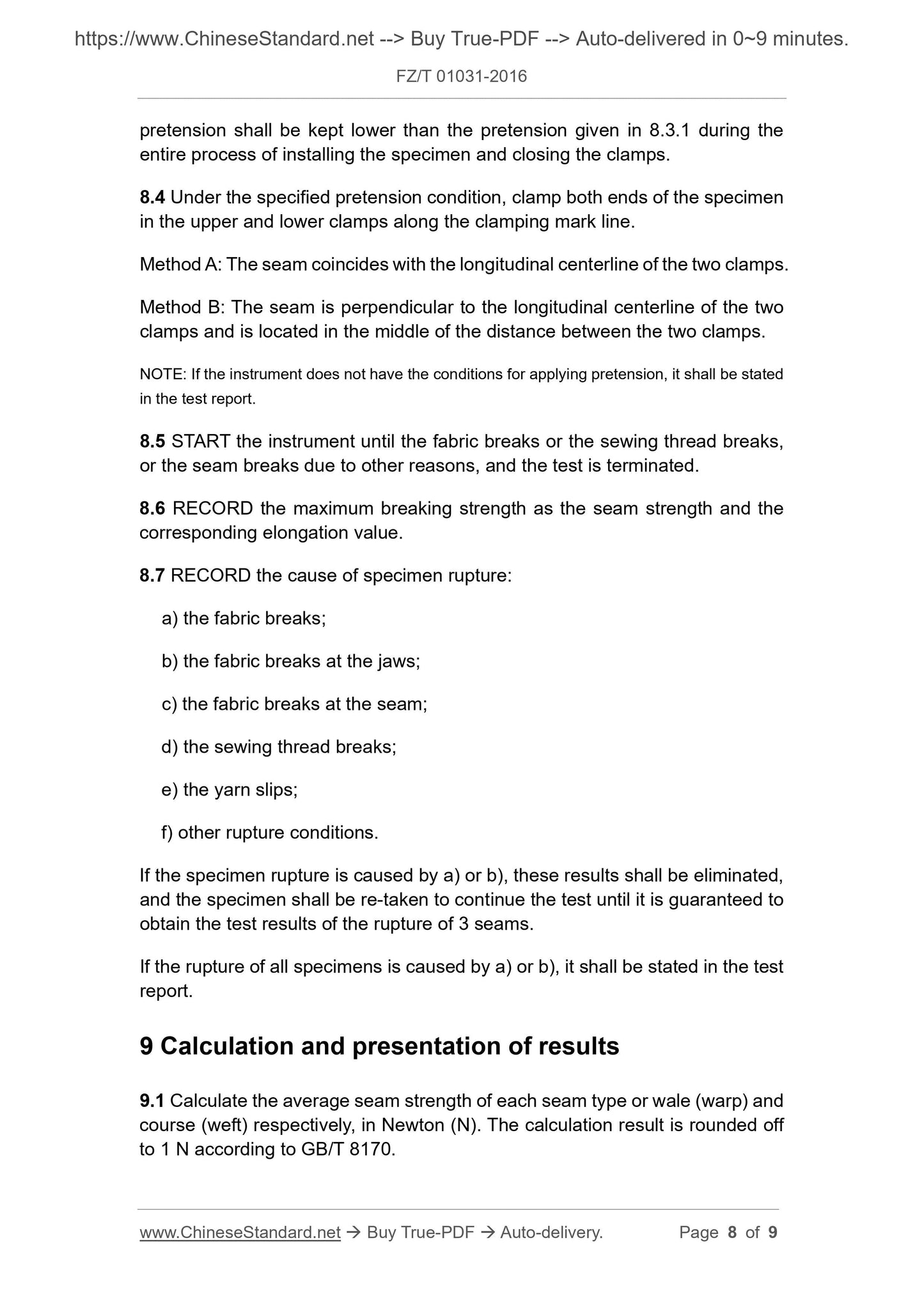1
/
of
5
PayPal, credit cards. Download editable-PDF and invoice in 1 second!
FZ/T 01031-2016 English PDF (FZT01031-2016)
FZ/T 01031-2016 English PDF (FZT01031-2016)
Regular price
$115.00 USD
Regular price
Sale price
$115.00 USD
Unit price
/
per
Shipping calculated at checkout.
Couldn't load pickup availability
Delivery: 3 seconds. Download true-PDF + Invoice.
Get QUOTATION in 1-minute: Click FZ/T 01031-2016
Historical versions: FZ/T 01031-2016
Preview True-PDF (Reload/Scroll if blank)
FZ/T 01031-2016: Knitted fabric and elastic woven fabric - Determination of maximum force to seam rupture and elongation - Grab method
FZ/T 01031-2016
FZ
TEXTILE INDUSTRY STANDARD OF
THE PEOPLE’S REPUBLIC OF CHINA
ICS 59.080.30
W 04
Replacing FZ/T 01031-1993
Knitted fabric and elastic woven fabric - Determination
of maximum force to seam rupture and elongation -
Grab method
ISSUED ON: APRIL 05, 2016
IMPLEMENTED ON: SEPTEMBER 01, 2016
Issued by: Ministry of Industry and Information Technology of the
People’s Republic of China
Table of Contents
Foreword ... 3
1 Scope ... 5
2 Normative references ... 5
3 Terms and definitions ... 5
4 Principle ... 6
5 Equipment ... 6
6 Conditioning and test atmosphere ... 6
7 Specimen ... 6
8 Steps ... 7
9 Calculation and presentation of results ... 8
10 Test report ... 9
Foreword
This Standard was drafted in accordance with the rules given in GB/T 1.1-2009.
This Standard replaces FZ/T 01031-1993 Knitted fabric and elastic woven
fabric - Determination of maximum force to seam rupture and elongation - Grab
tensile method. Compared with FZ/T 01031-1993, the main changes are as
follows:
- MODIFY the standard title, from “grab tensile method” to “grab method”;
- DELETE the reference to GB/T 5708 and GB/T 11050 in Clause 2 -
Normative references, and ADD the reference to GB/T 3923.2;
- MODIFY the requirements of Clause 5 - Equipment, to meet the
requirements of GB/T 3923.2;
- ADD the sewing and specimen cutting equipment required for 5.2 and 5.3
of this Standard;
- DELETE “Clause 6 - Requirements for sampling” of the old standard;
- SIMPLIFY the requirements of Clause 6 - Conditioning and test atmosphere,
and DELETE the specification on the conditioning time of specimens;
- MODIFY the sample sewing requirements in 7.2 of Clause 7 - Specimen
TO that the sewing requirements shall be determined according to the
relevant product standards or agreements between the parties concerned;
- DELETE steps 8.1 and 8.4 in Clause 8 of the old standard;
- DELETE the optional tensile speed of 200 mm/min in 8.2, and ADD the
annotation description of other test speeds;
- REFINE the cause of specimen rupture in 8.7, and SPECIFY the choice of
results;
- MODIFY the formula in 9.2 to the calculation method of seam elongation
dominated by loose clamping;
- ADD “a) the serial number of this Standard” in Clause 10 - Test report;
- DELETE Annex A and Annex B.
This Standard was proposed by China National Textile and Apparel Council.
This Standard shall be under the jurisdiction of Subcommittee on Basic
Knitted fabric and elastic woven fabric -
Determination of maximum force to seam rupture and
elongation - Grab method
1 Scope
This Standard specifies two tensile test methods to determine the seam
strength and elongation of the straight-line seam type of textiles. Method A is
the horizontal tensile method; Method B is the vertical tensile method.
This Standard applies to knitted fabrics and elastic woven fabrics.
2 Normative references
The following referenced documents are indispensable for the application of
this document. For dated references, only the edition cited applies. For undated
references, the latest edition of the referenced document (including any
amendments) applies.
GB/T 6529 Textiles - Standard atmospheres for conditioning and testing
GB/T 8170 Rules of rounding off for numerical values and expression and
judgement of limiting values
GB/T 3923.2 Textiles - Tensile properties of fabrics - Part 2: Determination of
maximum force using the grab method
3 Terms and definitions
For the purpose of this document, the following terms and definitions apply.
3.1
wale (warp) seam
A seam sewed perpendicular to the fabric in the wale (warp) direction.
3.2
course (weft) seam
pretension shall be kept lower than the pretension given in 8.3.1 during the
entire process of installing the specimen and closing the clamps.
8.4 Under the specified pretension condition, clamp both ends of the specimen
in the upper and lower clamps along the clamping mark line.
Method A: The seam coincides with the longitudinal centerline of the two clamps.
Method B: The seam is perpendicular to the longitudinal centerline of the two
clamps and is located in the middle of the distance between the two clamps.
NOTE: If the instrument does not have the conditions for applying pretension, it shall be stated
in the test report.
8.5 START the instrument until the fabric breaks or the sewing thread breaks,
or the seam breaks due to other reasons, and the test is terminated.
8.6 RECORD the maximum breaking strength as the seam strength and the
corresponding elongation value.
8.7 RECORD the cause of specimen rupture:
a) the fabric breaks;
b) the fabric breaks at the jaws;
c) the fabric breaks at the seam;
d) the sewing thread breaks;
e) the yarn slips;
f) other rupture conditions.
If the specimen rupture is caused by a) or b), these results shall be eliminated,
and the specimen shall be re-taken to continue the test until it is guaranteed to
obtain the test results of the rupture of 3 seams.
If the rupture of all specimens is caused by a) or b), it shall be stated in the test
report.
9 Calculation and presentation of results
9.1 Calculate the average seam strength of each seam type or wale (warp) and
course (weft) respectively, in Newton (N). The calculation result is rounded off
to 1 N according to GB/T 8170.
Get QUOTATION in 1-minute: Click FZ/T 01031-2016
Historical versions: FZ/T 01031-2016
Preview True-PDF (Reload/Scroll if blank)
FZ/T 01031-2016: Knitted fabric and elastic woven fabric - Determination of maximum force to seam rupture and elongation - Grab method
FZ/T 01031-2016
FZ
TEXTILE INDUSTRY STANDARD OF
THE PEOPLE’S REPUBLIC OF CHINA
ICS 59.080.30
W 04
Replacing FZ/T 01031-1993
Knitted fabric and elastic woven fabric - Determination
of maximum force to seam rupture and elongation -
Grab method
ISSUED ON: APRIL 05, 2016
IMPLEMENTED ON: SEPTEMBER 01, 2016
Issued by: Ministry of Industry and Information Technology of the
People’s Republic of China
Table of Contents
Foreword ... 3
1 Scope ... 5
2 Normative references ... 5
3 Terms and definitions ... 5
4 Principle ... 6
5 Equipment ... 6
6 Conditioning and test atmosphere ... 6
7 Specimen ... 6
8 Steps ... 7
9 Calculation and presentation of results ... 8
10 Test report ... 9
Foreword
This Standard was drafted in accordance with the rules given in GB/T 1.1-2009.
This Standard replaces FZ/T 01031-1993 Knitted fabric and elastic woven
fabric - Determination of maximum force to seam rupture and elongation - Grab
tensile method. Compared with FZ/T 01031-1993, the main changes are as
follows:
- MODIFY the standard title, from “grab tensile method” to “grab method”;
- DELETE the reference to GB/T 5708 and GB/T 11050 in Clause 2 -
Normative references, and ADD the reference to GB/T 3923.2;
- MODIFY the requirements of Clause 5 - Equipment, to meet the
requirements of GB/T 3923.2;
- ADD the sewing and specimen cutting equipment required for 5.2 and 5.3
of this Standard;
- DELETE “Clause 6 - Requirements for sampling” of the old standard;
- SIMPLIFY the requirements of Clause 6 - Conditioning and test atmosphere,
and DELETE the specification on the conditioning time of specimens;
- MODIFY the sample sewing requirements in 7.2 of Clause 7 - Specimen
TO that the sewing requirements shall be determined according to the
relevant product standards or agreements between the parties concerned;
- DELETE steps 8.1 and 8.4 in Clause 8 of the old standard;
- DELETE the optional tensile speed of 200 mm/min in 8.2, and ADD the
annotation description of other test speeds;
- REFINE the cause of specimen rupture in 8.7, and SPECIFY the choice of
results;
- MODIFY the formula in 9.2 to the calculation method of seam elongation
dominated by loose clamping;
- ADD “a) the serial number of this Standard” in Clause 10 - Test report;
- DELETE Annex A and Annex B.
This Standard was proposed by China National Textile and Apparel Council.
This Standard shall be under the jurisdiction of Subcommittee on Basic
Knitted fabric and elastic woven fabric -
Determination of maximum force to seam rupture and
elongation - Grab method
1 Scope
This Standard specifies two tensile test methods to determine the seam
strength and elongation of the straight-line seam type of textiles. Method A is
the horizontal tensile method; Method B is the vertical tensile method.
This Standard applies to knitted fabrics and elastic woven fabrics.
2 Normative references
The following referenced documents are indispensable for the application of
this document. For dated references, only the edition cited applies. For undated
references, the latest edition of the referenced document (including any
amendments) applies.
GB/T 6529 Textiles - Standard atmospheres for conditioning and testing
GB/T 8170 Rules of rounding off for numerical values and expression and
judgement of limiting values
GB/T 3923.2 Textiles - Tensile properties of fabrics - Part 2: Determination of
maximum force using the grab method
3 Terms and definitions
For the purpose of this document, the following terms and definitions apply.
3.1
wale (warp) seam
A seam sewed perpendicular to the fabric in the wale (warp) direction.
3.2
course (weft) seam
pretension shall be kept lower than the pretension given in 8.3.1 during the
entire process of installing the specimen and closing the clamps.
8.4 Under the specified pretension condition, clamp both ends of the specimen
in the upper and lower clamps along the clamping mark line.
Method A: The seam coincides with the longitudinal centerline of the two clamps.
Method B: The seam is perpendicular to the longitudinal centerline of the two
clamps and is located in the middle of the distance between the two clamps.
NOTE: If the instrument does not have the conditions for applying pretension, it shall be stated
in the test report.
8.5 START the instrument until the fabric breaks or the sewing thread breaks,
or the seam breaks due to other reasons, and the test is terminated.
8.6 RECORD the maximum breaking strength as the seam strength and the
corresponding elongation value.
8.7 RECORD the cause of specimen rupture:
a) the fabric breaks;
b) the fabric breaks at the jaws;
c) the fabric breaks at the seam;
d) the sewing thread breaks;
e) the yarn slips;
f) other rupture conditions.
If the specimen rupture is caused by a) or b), these results shall be eliminated,
and the specimen shall be re-taken to continue the test until it is guaranteed to
obtain the test results of the rupture of 3 seams.
If the rupture of all specimens is caused by a) or b), it shall be stated in the test
report.
9 Calculation and presentation of results
9.1 Calculate the average seam strength of each seam type or wale (warp) and
course (weft) respectively, in Newton (N). The calculation result is rounded off
to 1 N according to GB/T 8170.
Share
